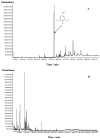Volatiles from a rare Acer spp. honey sample from Croatia
- PMID: 20657377
- PMCID: PMC6257633
- DOI: 10.3390/molecules15074572
Volatiles from a rare Acer spp. honey sample from Croatia
Abstract
A rare sample of maple (Acer spp.) honey from Croatia was analysed. Ultrasonic solvent extraction (USE) using: 1) pentane, 2) diethyl ether, 3) a mixture of pentane and diethyl ether (1:2 v/v) and 4) dichloromethane as solvents was applied. All the extracts were analysed by GC and GC/MS. The most representative extracts were 3) and 4). Syringaldehyde was the most striking compound, being dominant in the extracts 2), 3) and 4) with percentages 34.5%, 33.1% and 35.9%, respectively. In comparison to USE results of other single Croatian tree honey samples (Robinia pseudoacacia L. nectar honey, Salix spp. nectar and honeydew honeys, Quercus frainetto Ten. honeydew as well as Abies alba Mill. and Picea abies L. honeydew) and literature data the presence of syringaldehyde, previously identified in maple sap and syrup, can be pointed out as a distinct characteristic of the Acer spp. honey sample. Headspace solid-phase microextraction (HS-SPME) combined with GC and GC/MS identified benzaldehyde (16.5%), trans-linalool oxide (20.5%) and 2-phenylethanol (14.9%) as the major compounds that are common in different honey headspace compositions.
Figures
Similar articles
-
Oak (Quercus frainetto Ten.) honeydew honey--approach to screening of volatile organic composition and antioxidant capacity (DPPH and FRAP assay).Molecules. 2010 May 25;15(5):3744-56. doi: 10.3390/molecules15053744. Molecules. 2010. PMID: 20657511 Free PMC article.
-
Volatile composition screening of Salix spp. nectar honey: benzenecarboxylic acids, norisoprenoids, terpenes, and others.Chem Biodivers. 2010 Sep;7(9):2309-25. doi: 10.1002/cbdv.201000021. Chem Biodivers. 2010. PMID: 20860033
-
Headspace, volatile and semi-volatile organic compounds diversity and radical scavenging activity of ultrasonic solvent extracts from Amorpha fruticosa honey samples.Molecules. 2009 Jul 27;14(8):2717-28. doi: 10.3390/molecules14082717. Molecules. 2009. PMID: 19701118 Free PMC article.
-
[Recent advances in the application of headspace gas chromatography-mass spectrometry].Se Pu. 2018 Oct 8;36(10):962-971. doi: 10.3724/SP.J.1123.2018.05013. Se Pu. 2018. PMID: 30378354 Review. Chinese.
-
Applications of solid-phase microextraction and gas chromatography/mass spectrometry (SPME-GC/MS) in the study of grape and wine volatile compounds.Molecules. 2014 Dec 18;19(12):21291-309. doi: 10.3390/molecules191221291. Molecules. 2014. PMID: 25529017 Free PMC article. Review.
Cited by
-
Volatile organic compounds of Thai honeys produced from several floral sources by different honey bee species.PLoS One. 2017 Feb 13;12(2):e0172099. doi: 10.1371/journal.pone.0172099. eCollection 2017. PLoS One. 2017. PMID: 28192487 Free PMC article.
-
Mass Spectrometry Characterization of Honeydew Honey: A Critical Review.Foods. 2024 Jul 16;13(14):2229. doi: 10.3390/foods13142229. Foods. 2024. PMID: 39063313 Free PMC article. Review.
-
Release of terpenes from fir wood during its long-term use and in thermal treatment.Molecules. 2012 Aug 21;17(8):9990-9. doi: 10.3390/molecules17089990. Molecules. 2012. PMID: 22910123 Free PMC article.
References
-
- Soria A.C., Gonzales M., de Lorenzo C., Castro-Martinez I., Sanz J. Characterization of artisanal honeys from Madrid (central Spain) on the basis of their melissopalynological, physicochemical and volatile composition data. Food Chem. 2004;85:121–130. doi: 10.1016/j.foodchem.2003.06.012. - DOI
-
- Cuevas-Glory L.F., Pino J.A., Santiago L.S., Sauri-Duch E. A review of volatile analytical methods for determining the botanical origin of honey. Food Chem. 2007;103:1032–1043. doi: 10.1016/j.foodchem.2006.07.068. - DOI
-
- D’Arcy B.R., Rintoul G.B., Rowland C.Y., Blackman A.J. Composition of Australian honey extractives. 1. Norisoprenoids, monoterpenes, and other natural volatiles from Blue Gum (Eucalyptus leucoxylon) and Yellow Box (Eucalyptus melliodora) J. Agric. Food Chem. 1997;45:1834–1843. doi: 10.1021/jf960625+. - DOI
-
- Zima D. Contribution to the knowledge of honey-rich plants in Croatia. Agronomski glasnik. 2007;2:147–160.
Publication types
MeSH terms
Substances
LinkOut - more resources
Full Text Sources
Miscellaneous


